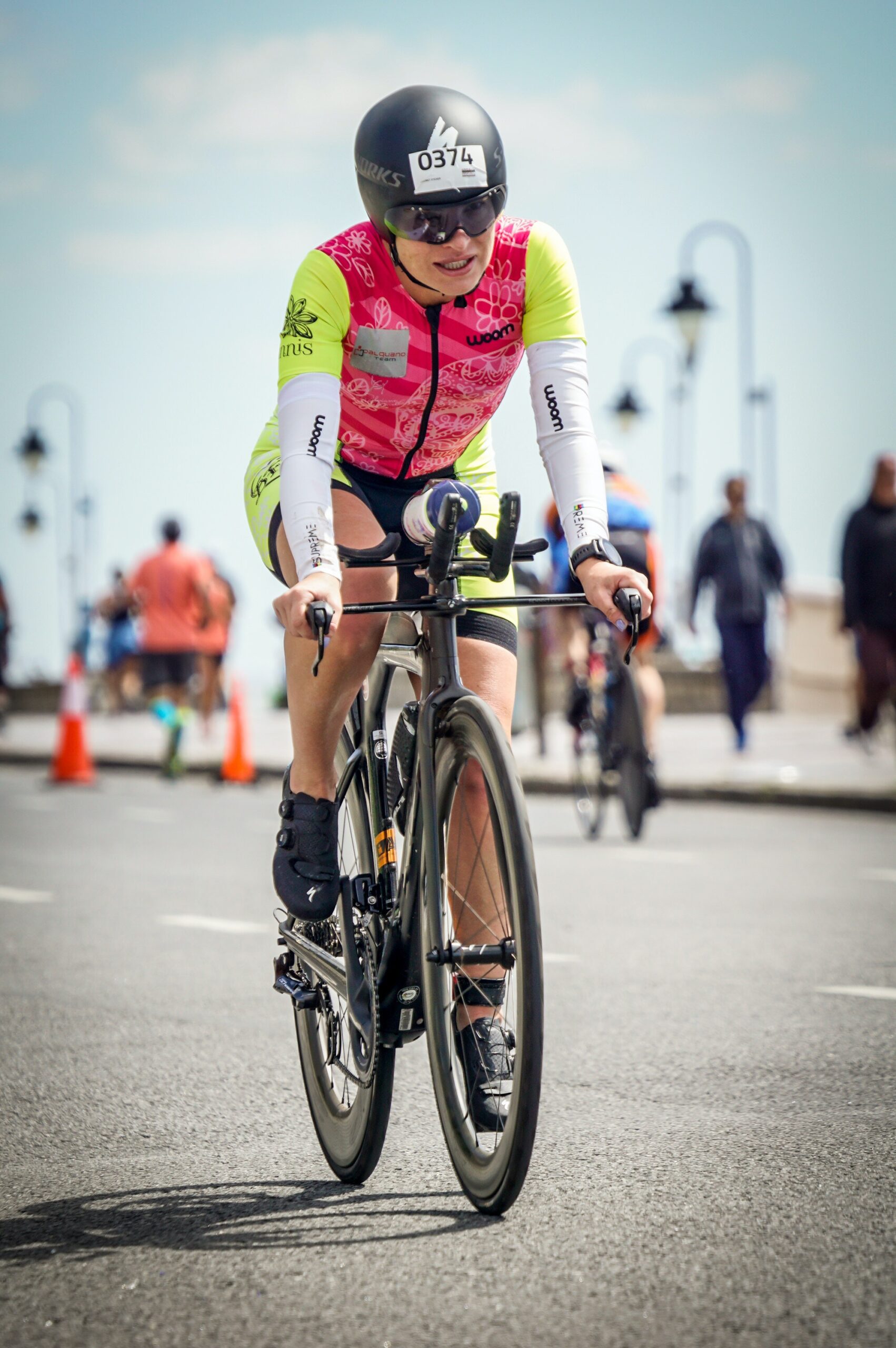Let’s be realistic. The primary obstacle to pushing your physical limits is pain. Your ability to tolerate and manage the pain you experience in your training will determine how hard, fast, and far you go, the gains you make in your fitness, and how you perform in races.
 So, the $64,000 question is: What can you do to lessen the pain you feel during training and in races and tolerate the pain that is inevitable as you push your limits. In a previous article, I shared with you some scientifically proven strategies you can use to better manage your exertion pain. I want to share with you another powerful mental tool you can use to go beyond your perceived physical limits.
So, the $64,000 question is: What can you do to lessen the pain you feel during training and in races and tolerate the pain that is inevitable as you push your limits. In a previous article, I shared with you some scientifically proven strategies you can use to better manage your exertion pain. I want to share with you another powerful mental tool you can use to go beyond your perceived physical limits.
But, first, a bit of background. Pain evolved for a very good reason. When our ancestors felt pain, death was likely to follow. So, the pain they experienced had essential survival value. The problem is that, in 2023 triathlon life, our primitive brains don’t know the difference between survival pain and the pain we subject ourselves to while training and racing. Our brain feels the physical pain and signals our bodies to slow down or stop to ease the pain.
2023 triathlon life, our primitive brains don’t know the difference between survival pain and the pain we subject ourselves to while training and racing. Our brain feels the physical pain and signals our bodies to slow down or stop to ease the pain.
Thankfully, we humans have an evolved brain that gives us the ability to override those primitive survival urges (at least to a point), notably, our pre-frontal cortex. This part of our cerebral cortex is responsible for what is called ‘executive functioning,’ which is involved in weighing risks and reward, short-term vs. long-term consequences, identifying options, and, most relevant to we triathletes, the ability to make deliberate choices. In other words, we have the capacity to decide whether to keep going or slow down (except in the face of extreme physiological failure; think Julie Moss in 1982).
 I characterize this ‘fork in the road’ as a simple, but not easy, choice. It’s simple, because would you rather keep pushing forward and have a chance to achieve your training or race goals, or ease up and fail to reach our triathlon goals? Obviously, we would all choose the former option. But it’s not easy because we are resisting billions of years of evolution and, during extreme training or race exertion, our bodies are screaming at us to stop.
I characterize this ‘fork in the road’ as a simple, but not easy, choice. It’s simple, because would you rather keep pushing forward and have a chance to achieve your training or race goals, or ease up and fail to reach our triathlon goals? Obviously, we would all choose the former option. But it’s not easy because we are resisting billions of years of evolution and, during extreme training or race exertion, our bodies are screaming at us to stop.
My strategy hasn’t been scientifically tested, but it does align with the predominant explanation, ‘Central Governor Theory,’ for why we slow down when we experience exertion fatigue and pain. Its premise is that our brains signal our muscles to slow down far before they are physiologically incapable of performing. So, it’s not muscle failure itself that causes us to slow down, but the brain’s commands to slow the body down to protect it from damage or worse.
I discovered my new mental tool not by studying it, but by living it. About a month ago, I was doing a challenging workout on my indoor trainer, a Zone 5-VO2Max workout of 5x5min intervals. I was struggling the last few minutes of the intervals with my legs burning, heart pounding, and breathing on the edge of losing control. After the first interval (after which I wasn’t sure I could do four more), I had a thought just pop into my head (this is how I get most of my ideas): “I choose to push my limits.” And, amazingly, the trend of my wattage reversed, and I actually rose to the top of my coach’s, Dr. Greg Rhodes, power range. Not only did I finish that interval strong, but I actually increased my average power for the remaining intervals. Yes, it was still hard, but it wasn’t as painful as it had been and I was able to push through the pain and hit my workout #s.
challenging workout on my indoor trainer, a Zone 5-VO2Max workout of 5x5min intervals. I was struggling the last few minutes of the intervals with my legs burning, heart pounding, and breathing on the edge of losing control. After the first interval (after which I wasn’t sure I could do four more), I had a thought just pop into my head (this is how I get most of my ideas): “I choose to push my limits.” And, amazingly, the trend of my wattage reversed, and I actually rose to the top of my coach’s, Dr. Greg Rhodes, power range. Not only did I finish that interval strong, but I actually increased my average power for the remaining intervals. Yes, it was still hard, but it wasn’t as painful as it had been and I was able to push through the pain and hit my workout #s.
I have used this strategy many times since, in the pool, on my bike, and during runs, and it really works! As a serious triathlete, I was thrilled with the impact it has had on my training. As a mental coach, I was really curious about why it works. Here is what I came up with to explain its power.
 First, as noted above, it is consistent with the Central Governor Theory of fatigue and pain. If the primitive and unconscious part of our brains can tell our bodies to stop, the evolved and conscious part of our brains can take control and tell our bodies to keep going (because, again, the desire to slow down is not usually due to physiological depletion).
First, as noted above, it is consistent with the Central Governor Theory of fatigue and pain. If the primitive and unconscious part of our brains can tell our bodies to stop, the evolved and conscious part of our brains can take control and tell our bodies to keep going (because, again, the desire to slow down is not usually due to physiological depletion).
I also recognized several other key contributors to the positive influence of my statement, “I choose to push my limits.”
When we make a choice, we are exerting control over ourselves. Research related to how we experience pain has shown that we humans really like being in control (for survival reasons) and that even a perceived sense of control (i.e., when we think we’re in control, but we’re really not) can reduce

our experience of pain. When I say, “I choose to push my limits,” I am taking control of my discomfort and sending a message to my primitive brain that I’ve got everything under control and that my body isn’t in danger. In doing so, my survival instinct isn’t triggered and I’m more readily able to push myself during grueling workouts and in races.
Pushing our limits also has a mental component to it; it is our minds that get our bodies to keep going when they want to stop. Making the choice to push my limits reminds me why I’m doing it, namely, to achieve some very big goals in the 2023 triathlon season. In other words, I give my body a reason to hurt.
 The first two contributors to pushing our limits also generate positive emotions, such as inspiration, pride, and excitement, which are rocket fuel in our training and race efforts. If you can feel ‘propulsive,’ rather than weakening, emotions, you are more likely to be able to overcome your primitive urges to slow down when you are hurting.
The first two contributors to pushing our limits also generate positive emotions, such as inspiration, pride, and excitement, which are rocket fuel in our training and race efforts. If you can feel ‘propulsive,’ rather than weakening, emotions, you are more likely to be able to overcome your primitive urges to slow down when you are hurting.
Finally, all of these contributors to pushing our limits produce physiological changes, in

cluding increased adrenaline, blood flow, and oxygen, that enable us to tap into our physical reserves and continue to push to the very end. You’re able to convert mental and emotional energy into that rocket fuel that will propel you forward.
So, next time you’re in your ‘hurt locker’ in training or racing, say to yourself, “I choose to push my limits,” and you’ll be amazing at what happens.



